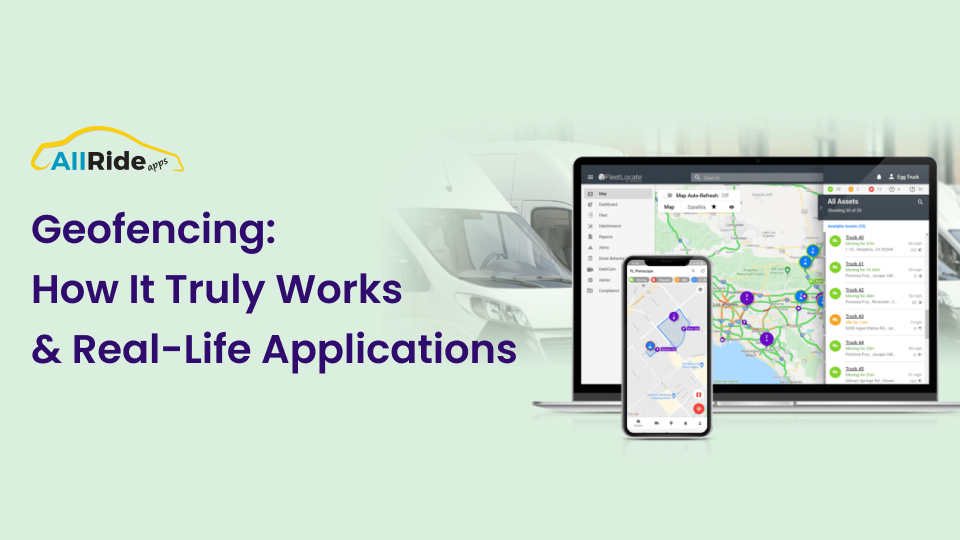
What Is Geofencing And How Does It Work?
The application of GPS, or global positioning systems, has widely increased with advancing technology. In the context of fleet management, GPS is being used far beyond simple route navigation. Businesses are finding creative ways to use virtual positioning and navigation systems to gain a holistic overview of business operations.
Geofencing is one such use case that brings multiple business benefits to fleet companies worldwide. As a service, businesses can configure the service according to their specific needs to optimize expenses and boost cost-efficiency. Continue reading to learn more about geofencing and how we can use it to monitor vehicles as part of a fleet management system.
What Is A Geofence?
As the name suggests, a geofence is a virtual boundary defined by GPS and RFID technologies. It is a location-based service where geographic boundaries trigger specific pre-programmed responses like vehicle tracking, push notifications, targeted advertisements, etc. A geofence can be as small as a building and even more comprehensive than a zip code.
Geofencing finds widespread use in multiple industries. Specifically, we can pair fleet management with RFID tags and GPS receivers to monitor vehicles, track driver behavior, and ensure that fleet assets do not leave designated areas.
Benefits of geofencing
-
Spend effectiveness
When applied correctly, geofencing significantly improves spending effectiveness. As a fleet manager, you can monitor your drivers’ routes in a region and track unnecessary stops to reduce idle time. Setting up geofences significantly improves fleet productivity, thereby boosting cost-effectiveness.
-
Improved data collection
After installing the requisite hardware, fleet managers and operators gain access to a ton of actionable insights that they can use to make smarter business decisions. For instance, you can study traffic patterns, vehicle issues in correlation to routes taken, driver behavior, etc.
How Does Geofencing Work?
The first step in setting up geofencing for a fleet requires the fleet administrator to work with a software developer to establish a virtual “fence” surrounding a geographical region. It involves using GPS- and/or RFID-enabled software, where a geofence can be specified using APIs when developing the mobile app.
A geofence is usually defined within a mobile app’s code, and users will need to enable location access to their devices for this feature to work. During development, developers can specify either a polygon or a radius around a defined point. For instance, a retailer can set up a geofence within the delivery app to trigger mobile alerts for customers using the application within the specific boundaries in a zip code.
Advanced fleet management software solutions allow fleet operators and business owners to set up their own geofences for their vehicles. Setting up virtual perimeters only takes a few minutes, and you can customize the geofences for particular routes and vehicles.
Once you’ve set up the geofence specific to your fleet, you can then set it to trigger a myriad of actions, e.g., send push notifications to fleet managers, alarm warnings to the drivers, monitor vehicle statistics, etc.
Now that you know how it works let’s look at how you can use geofencing to manage your fleet more efficiently.
How And Why You Should Be Using Geofencing In Fleet Management
Digitizing your business operations and integrating innovative technologies like geofencing helps you mitigate the fleet management industry challenges. Here is why you should be using geofencing in fleet management.
-
Track assets in the real world
If your business delivers high-risk and high-value cargoes (e.g., medicines, refrigerated goods, etc.), tracking assets in the real world is indispensable. Geofencing significantly improves visibility into the delivery supply chain from the origin to the destination. For instance, you can set up designated locations that trigger alarms or send notifications when a vehicle leaves, reducing the risk of stolen assets.
-
Eliminate off-hours use of vehicles
Worried about asset exploitation? Geofencing is a great way to tackle this issue too if your drivers cannot use company vehicles for personal use. You can set up geofences for the drivers and get alerts whenever employees misuse company assets. These alerts can be a great way to gain insights on when and where the vehicles are used, fuel consumption, etc. With worst offenders, you can provide feedback on how to correct this behavior.
-
Prevent vehicles from overlapping territories
Many fleets often operate within particular territories, which can be due to team division, licensing, etc. In these situations, fleet administrators need a holistic overview of the area where the vehicles work and ensure that they stay within the designated region. Geofencing is perfect for this use case. It allows fleet managers to contact drivers straying away from their geofenced area and fix errors as quickly as possible.
-
Ensure better driver safety
Drivers are on the road for multiple hours at a time for thousands of miles a month. Fleet operators must keep in touch with their drivers and provide solutions as quickly as possible. For instance, when a vehicle has been idle for a long time or strayed outside the geofence, administrators can assist drivers immediately. It offers invaluable peace of mind to both fleet owners and drivers, knowing that help is ready whenever needed.
Applications Of Geofencing In Different Industries
The growing popularity of mobile applications has made geofencing a standard practice for many businesses. Defining a geographical area and getting trigger actions opens up various possibilities on what companies can do. Some of them include:
-
Social networking (push notifications)
Arguably, one of the most noticeable applications of geofencing is in social networking. Companies provide location-based connection suggestions, filters, stickers, etc., within pre-defined virtual parameters.
-
Marketing and advertising
Apart from social media, geofencing also allows companies worldwide to advertise to specific customers within a location. For instance, businesses can use virtual fences to run location-specific ad campaigns, in-store promotions, etc.. It allows businesses to discover strategies that work best within a specific area.
-
Workplace and employee tracking
For companies that rely on fieldwork, e.g., sales teams, etc., geofencing is an intuitive way to monitor employees and where they work. Companies can combine it with other technologies to automate time cards, approve allowances, etc.
How To Implement Geofencing In Your Fleet
To set up geofences to track your fleet operations, you will need to partner with a fleet management software provider like AllRide Apps. With specific virtual perimeters, you can monitor your assets in the real world, how your employees utilize them, and get real-time notifications when someone breaches these fences. The right software will make it easy to get feedback on driver behavior, safety, and vehicle use.




